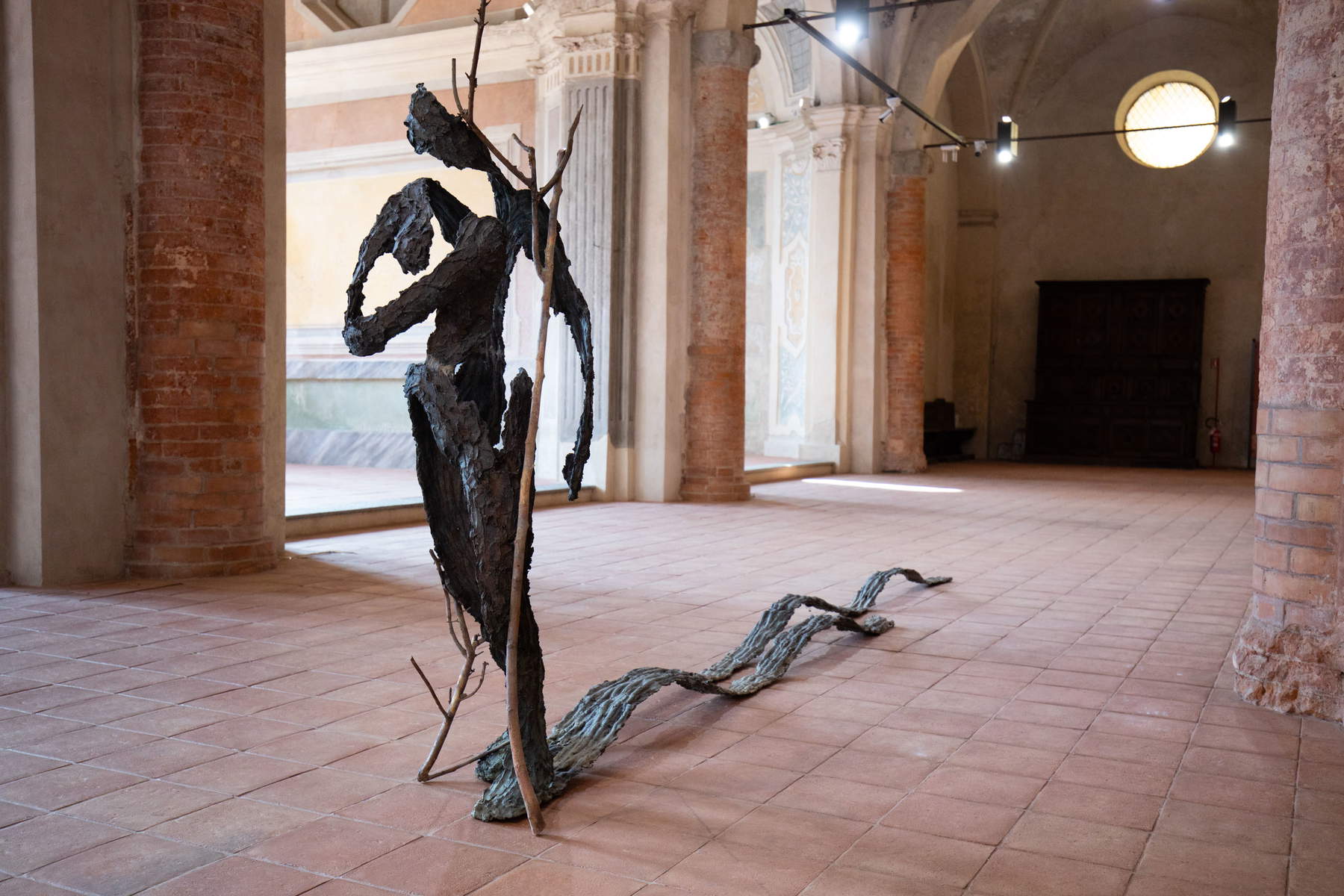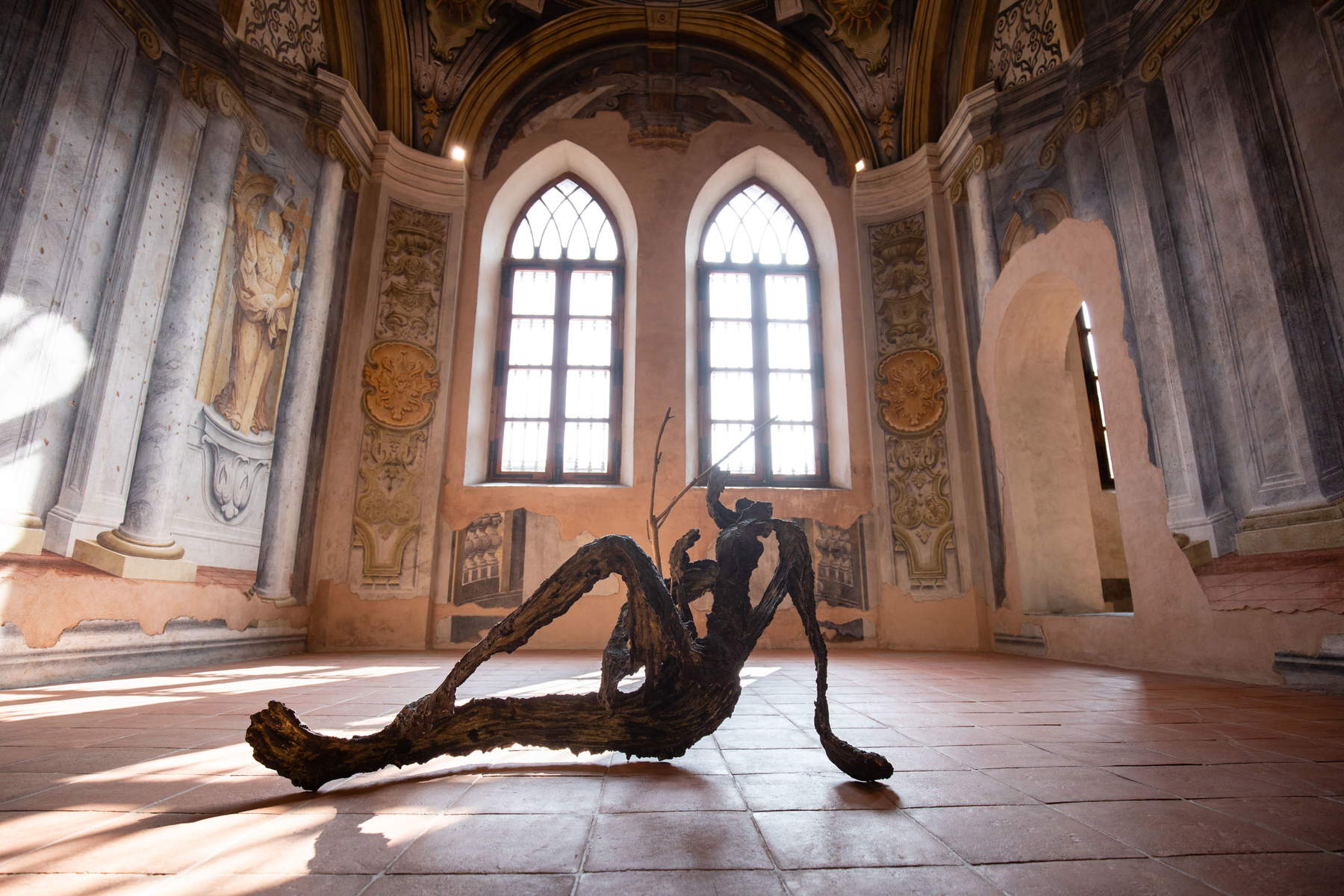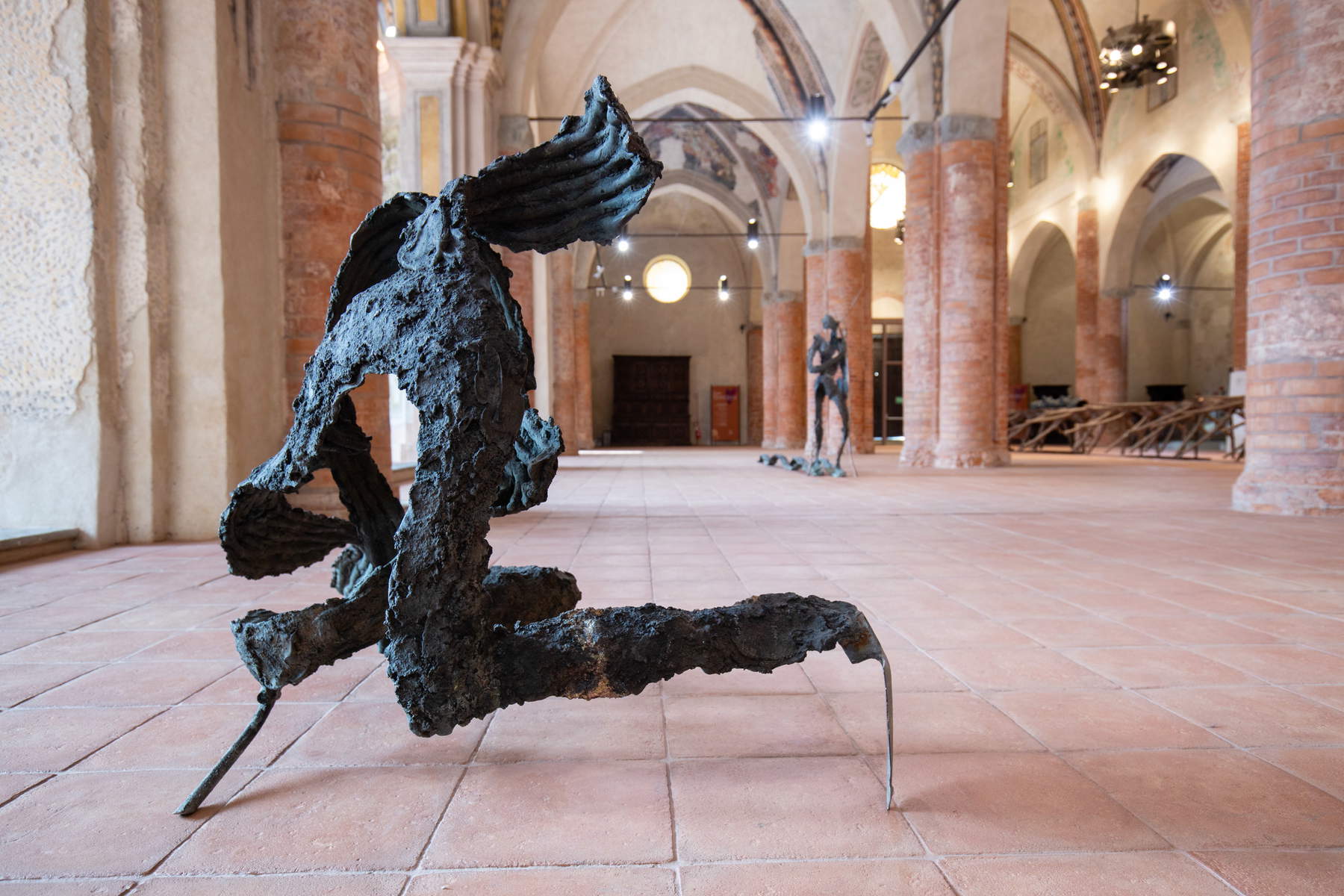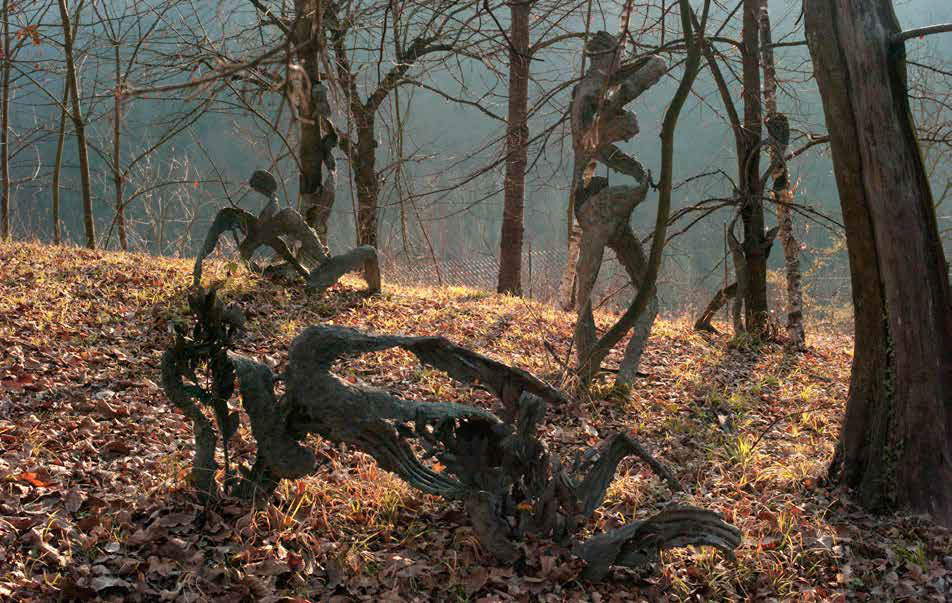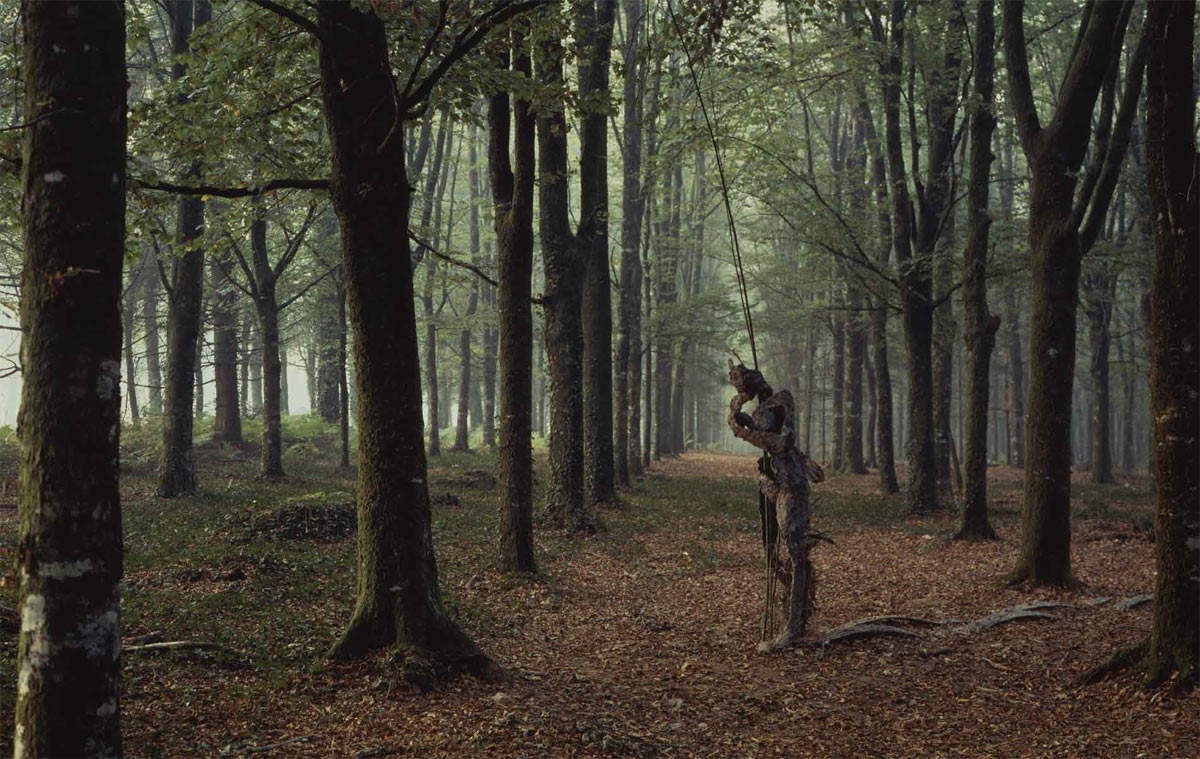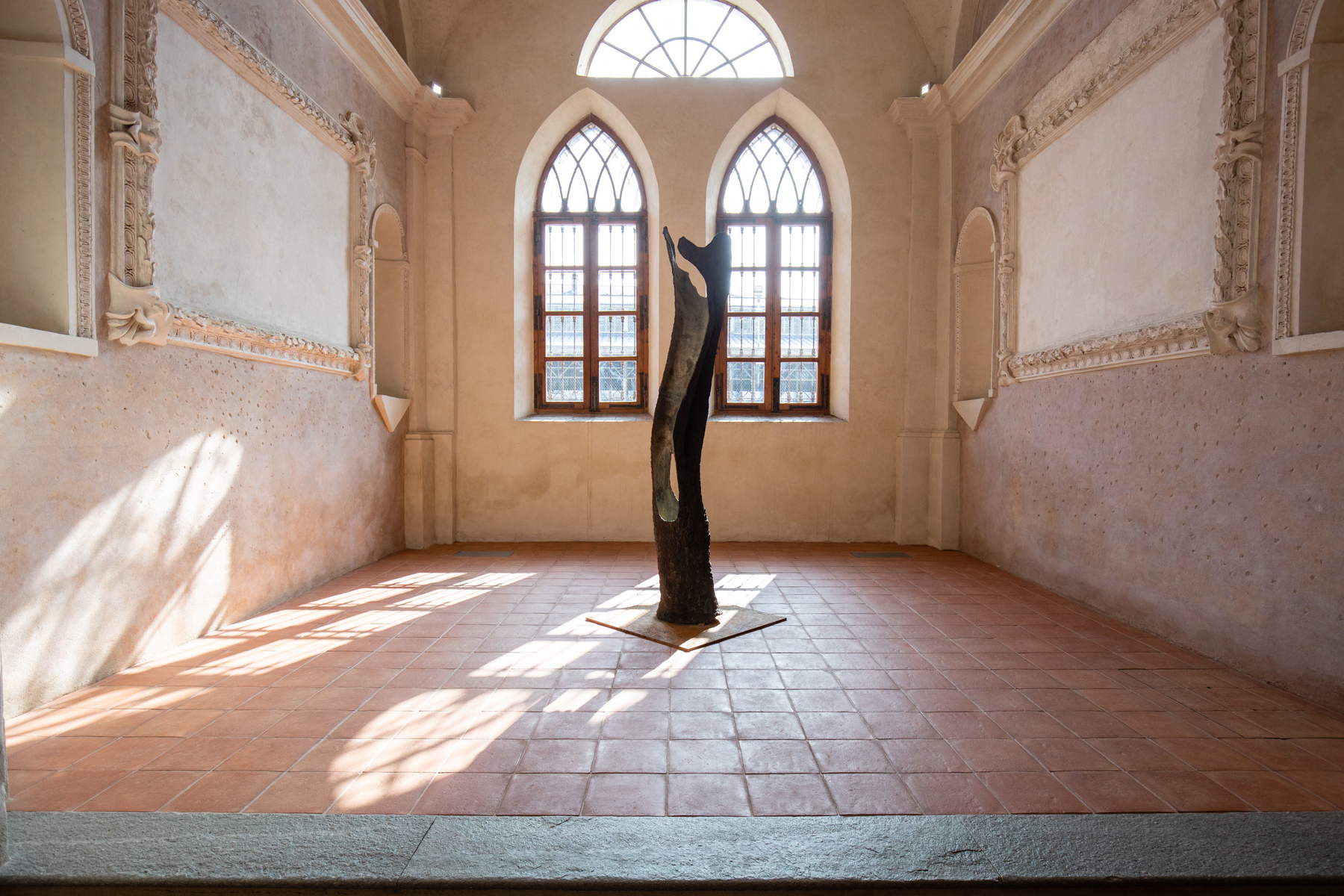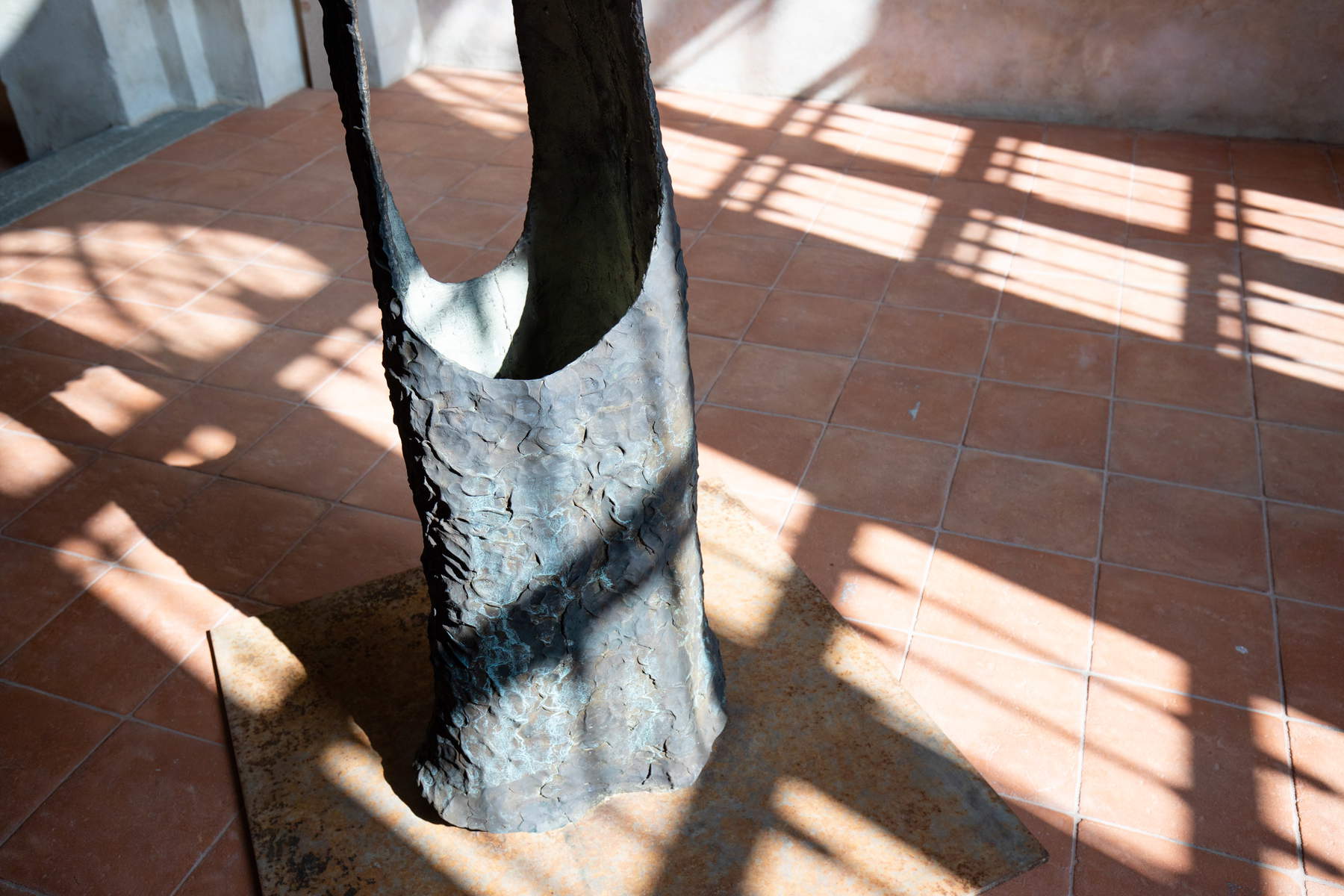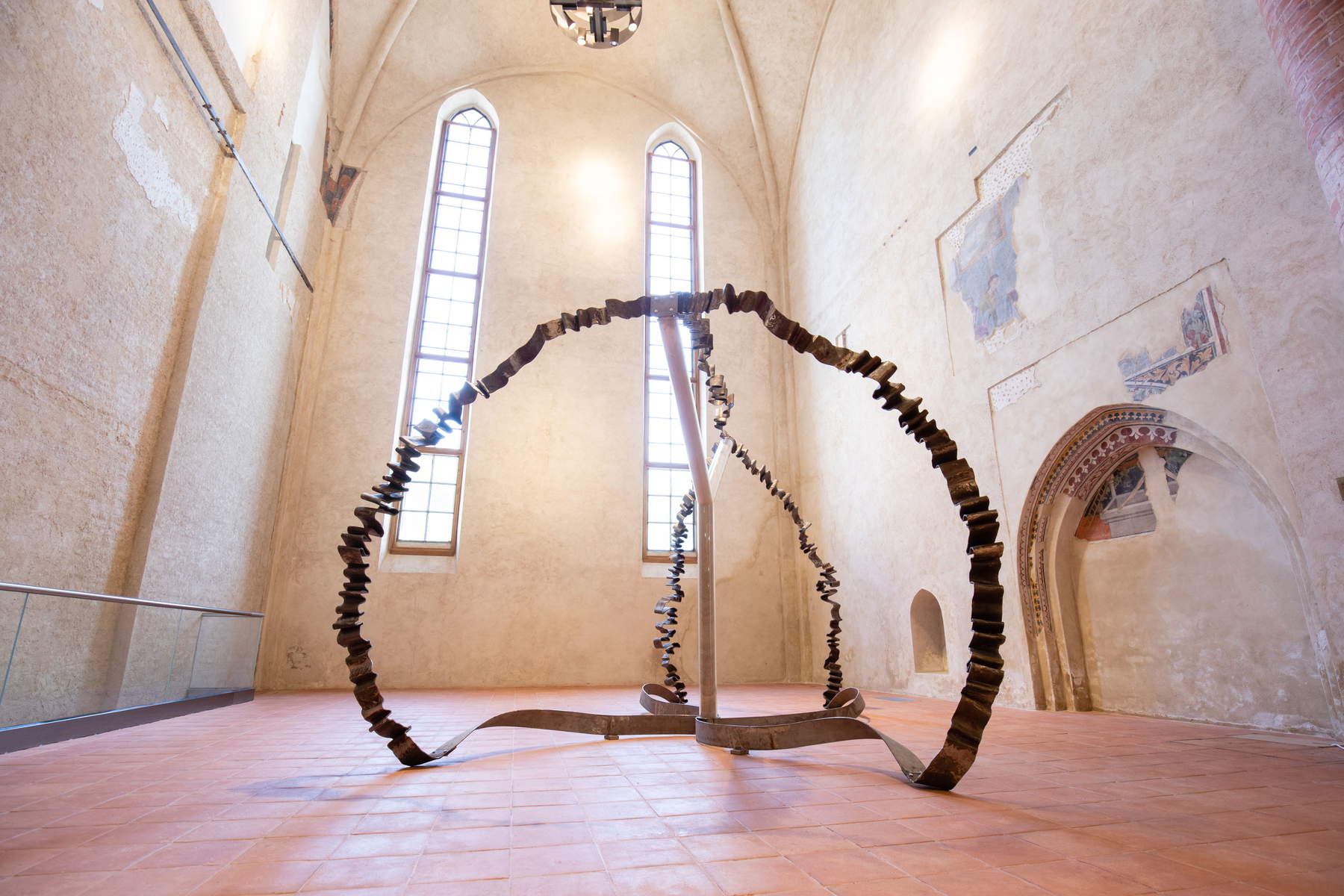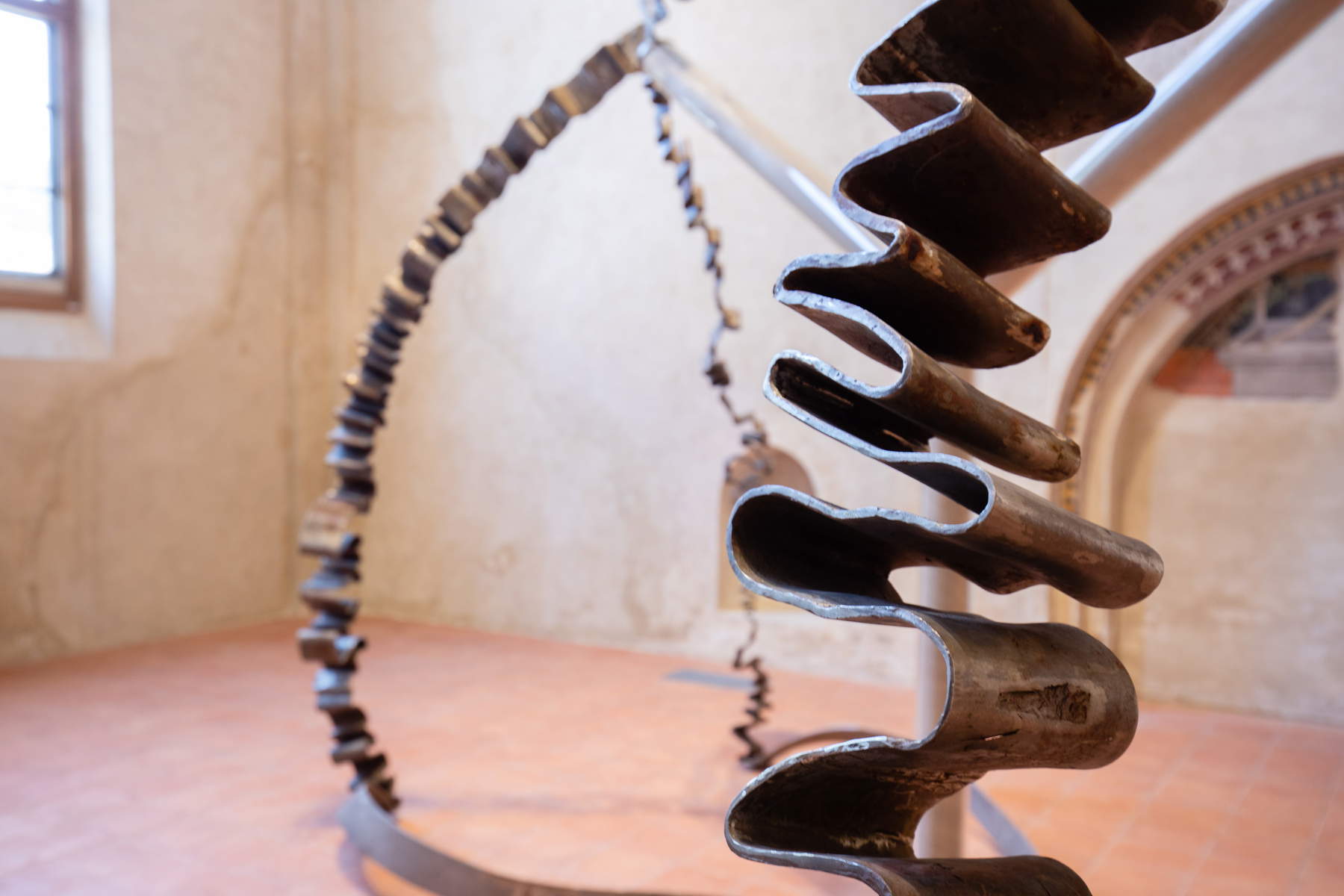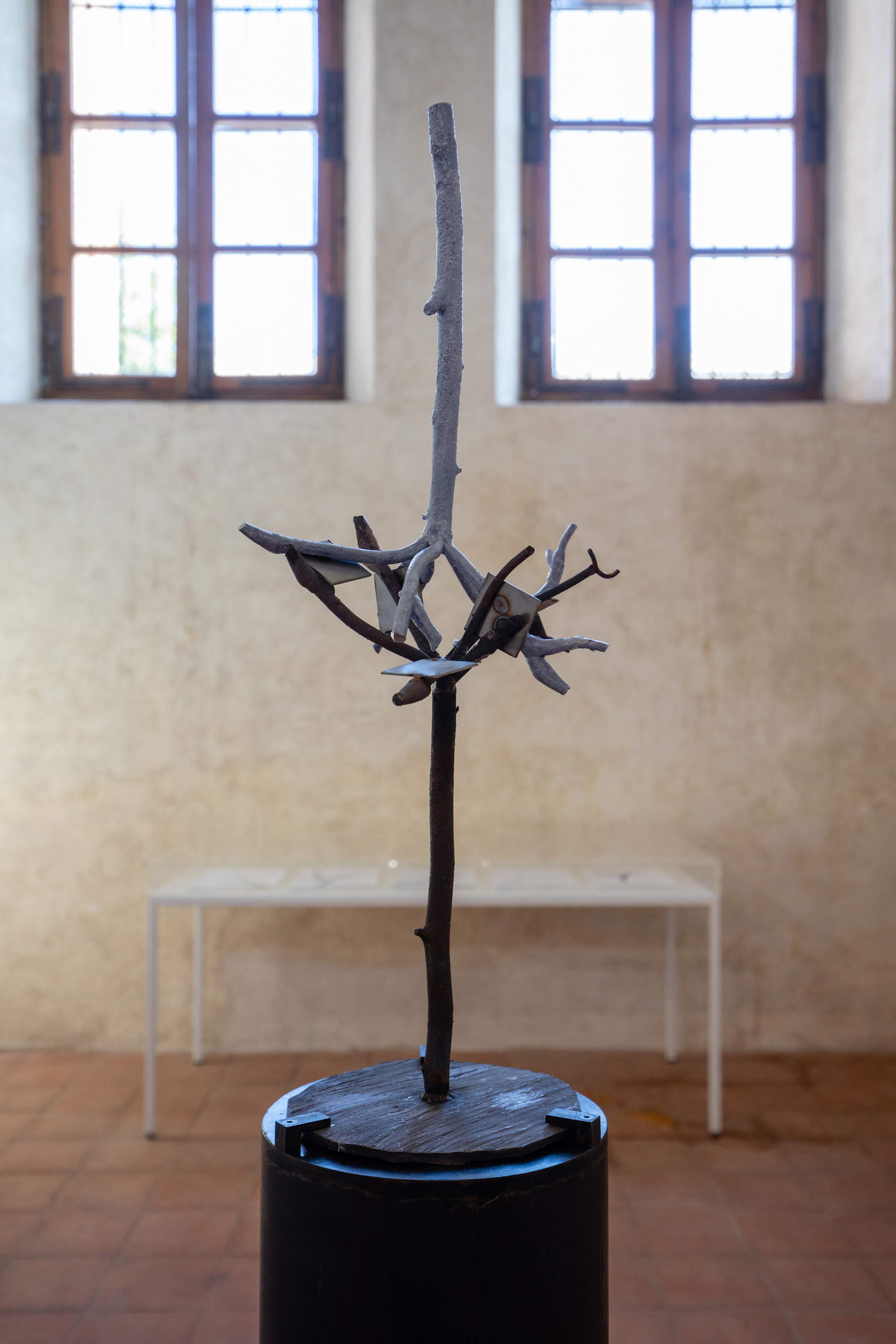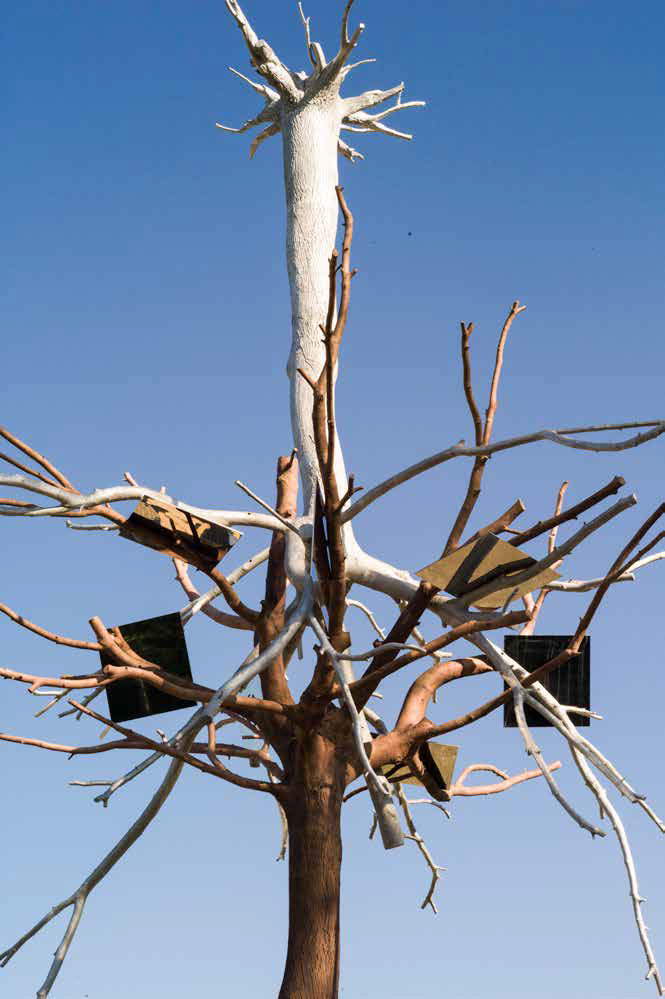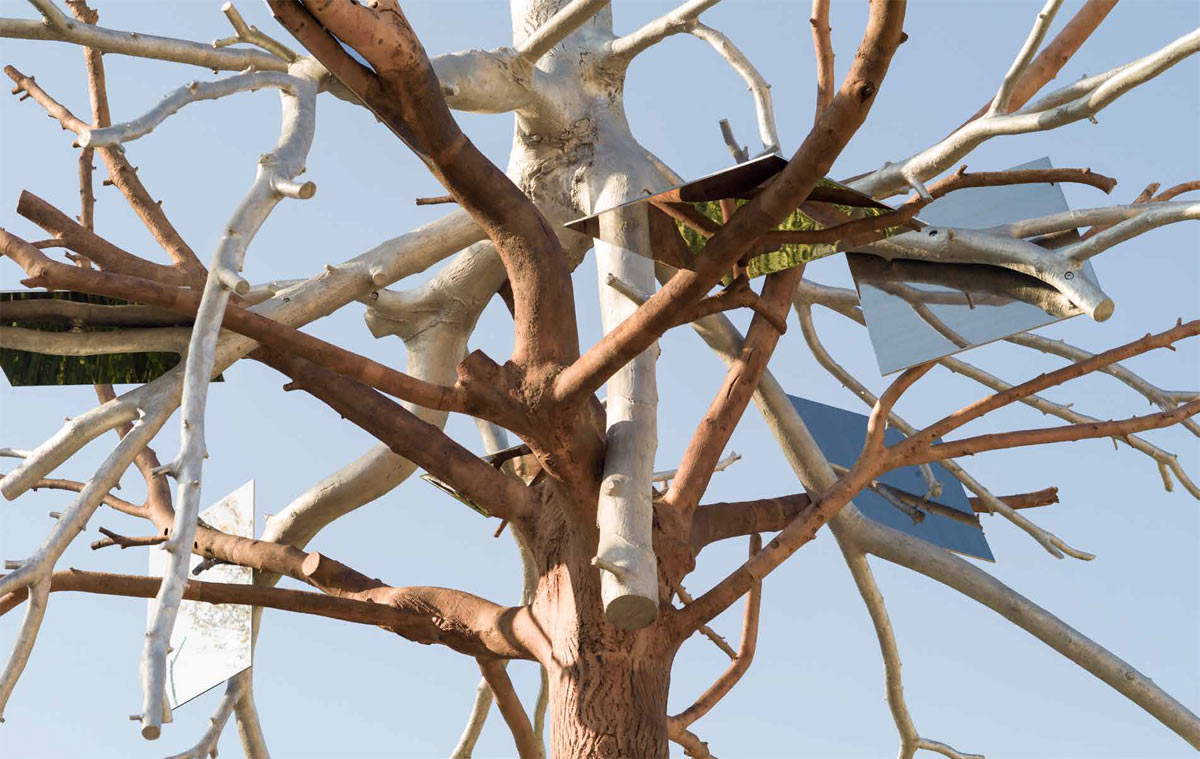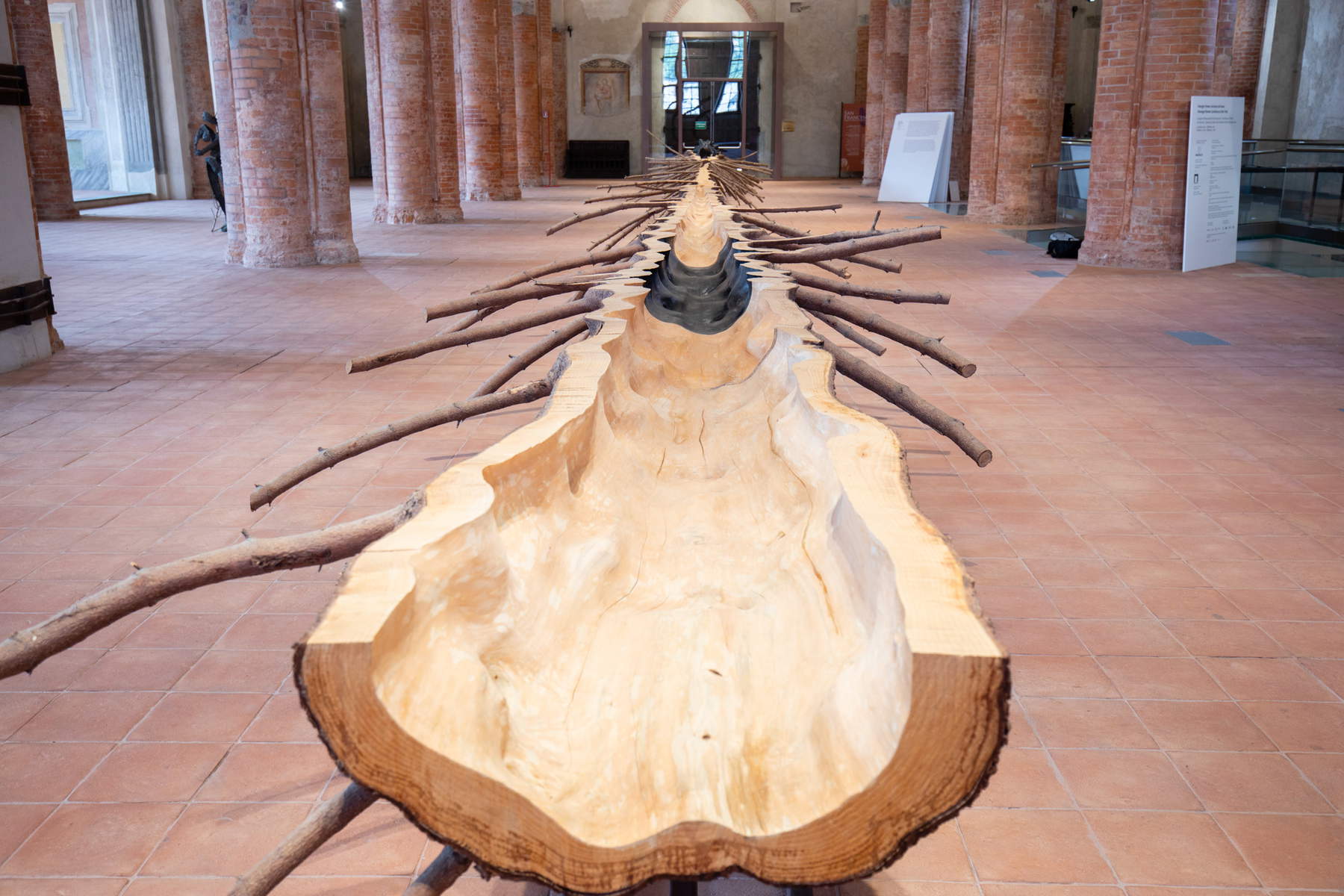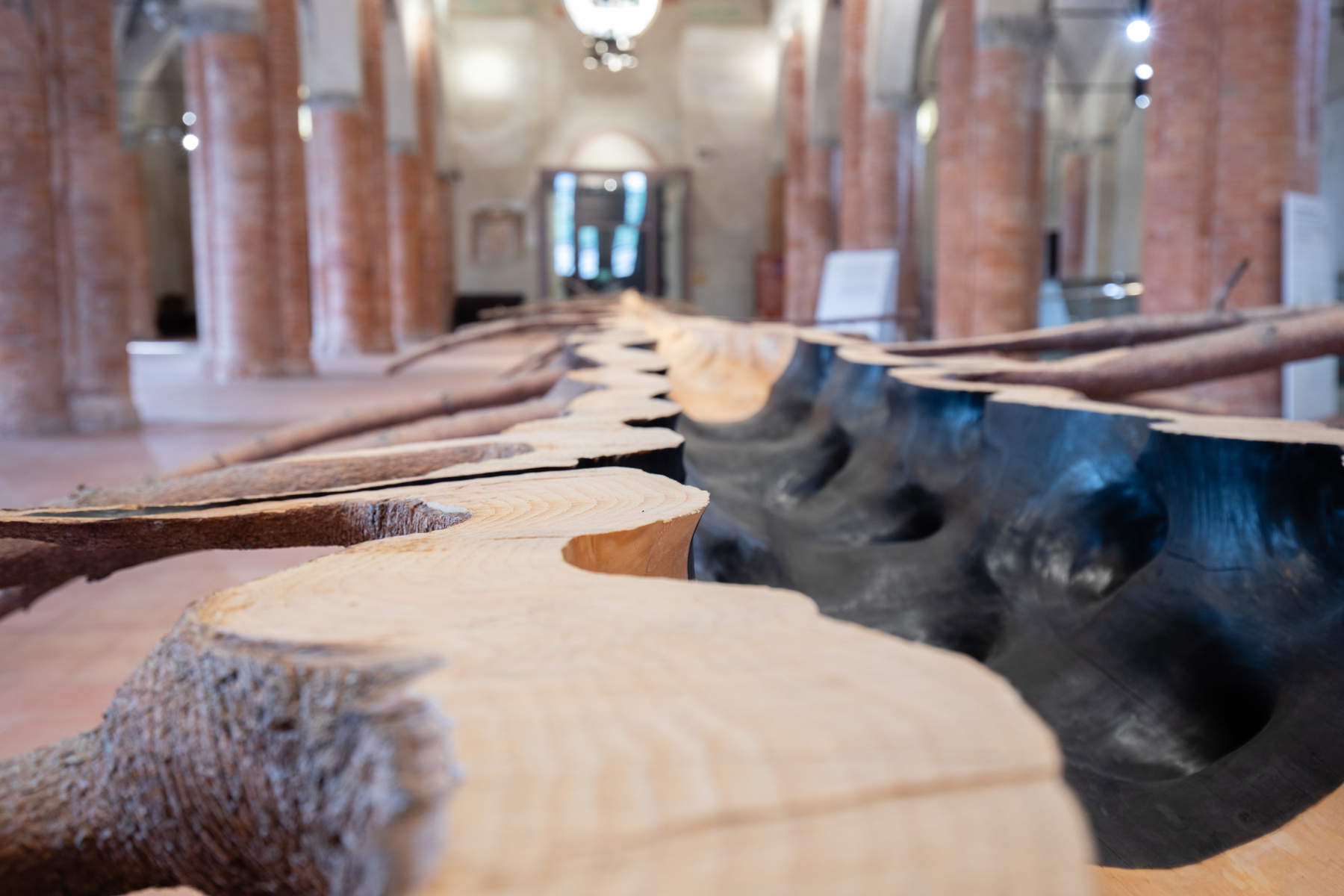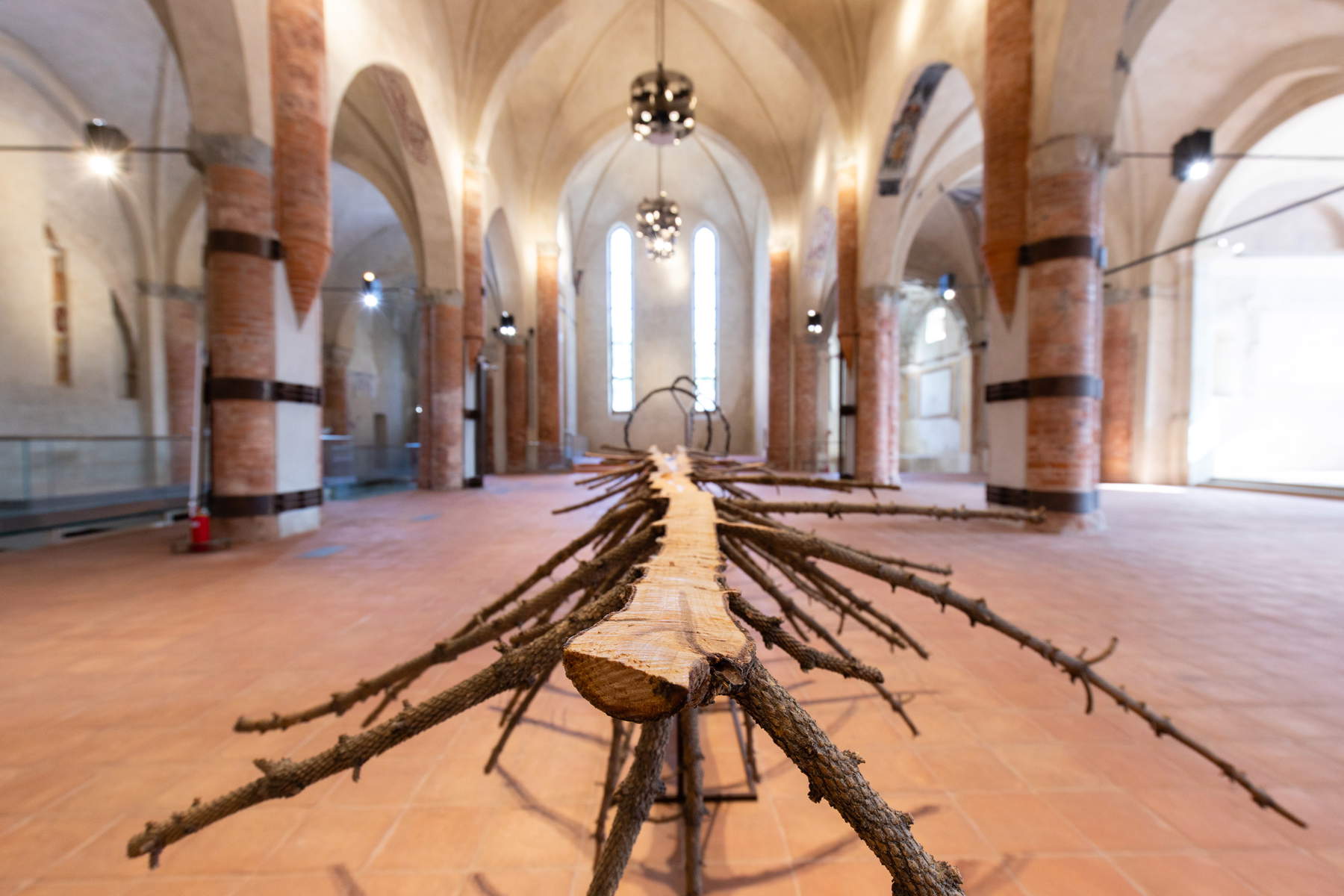by Federico Giannini, Ilaria Baratta , published on 21/01/2020
Categories: Works and artists
/ Disclaimer
Until February 2, 2020, the Church of San Francesco in Cuneo and Rivoli Castle are hosting the exhibition "Giuseppe Penone. Incidences of the Void," curated by Carolyn Christov-Bakargiev, and promoted by the CRC Foundation of Cuneo together with Rivoli Castle. In this article, a unified reading of the works on display from the perspective of the nature-culture relationship in Giuseppe Penone's art
“A sharp division between human and nature is a vision forced by reality.” This was said by Giuseppe Penone (Garessio, 1947) to art historian Arabella Natalini in a conversation published in the catalog of his solo exhibition Prospettiva vegetale held in the summer of 2014 at Forte di Belvedere in Florence. Since his beginnings in the late 1960s, Penone has always considered nature, culture and the human being as connected and indivisible entities, and sculpture as a kind of medium to express these connections. The starting point for this reflection was very practical, if you will: the theme of the relationship with nature had been touched on marginally in twentieth-century art. And it was a theme that was of little or no interest to the avant-garde: “all twentieth-century art,” Penone asserted in that context, “is art that developed in the atelier, in an urban context, in a completely urban dimension.” And it was only in the 1960s that the idea of a return to nature as well as to a “much more open vision of things and less constrained to the idea of a progress of artwork” developed. This return, however, also presupposed a new method of working: the artwork was no longer an object detached from its context, but became part of the context itself, and the material no longer just a medium, but the very object of the artist’s reflection. The relationship between nature and culture is, moreover, central not only for Penone but for virtually all the artists who animated theArte Povera movement, of which the Piedmontese sculptor has been a part since its inception: “poor,” according to the term coined in 1967 by art critic Germano Celant, in that it presupposes an attitude (understood not only as artistic practice, but also in the literal sense of a way of behaving) that “prefers informational essentiality, that does not dialogue with either the social system or the cultural system, that aspires to present itself suddenly, unexpectedly with respect to conventional expectations, an asystematic living, in a world where the system is everything.” Since that of arte povera is an unconventional approach, such must also be the materials: which thus become “poor,” precisely.
Penone’s research is distinguished from the outset by the use of materials on the one hand present in nature (wood, water, stone, leaves, even the artist’s own skin), and on the other always present in art (clay, marble, bronze), in order to arrive at what was the common goal of the poverists: “to create real situations of both elemental energy, both physical-chemical and emotional-philosophical” (thus Carolyn Christov-Bakargiev in the catalog of the exhibition Incidences of the Void). Physical and philosophical (i.e., paraphrasing, natural and cultural: underlying the adjective “physical” is the term by which the ancient Greeks identified nature, namely phýsis, although for the Greeks the word had a broader meaning and also indicated the origin of things, while “philosophy” is, etymologically, “the love of knowledge”) because, for Arte Povera artists, Christov-Bakargiev continues, “nature and culture are mutually defined and related because nature (everything that is not artificial, not created by man, but arises spontaneously) is a cultural concept, while culture is not exempt from nature but is subject to its laws.” And so this is why the interaction between man and nature becomes one of the foundations of Penone’s art, right from his early works: one of the earliest moments of this reflection is the Alpi Marittime series, photographs that Penone took in 1968, when he was only 21 years old, to document some of his actions performed in the woods of his Piedmont region, during which he fixed a metal cast of his own hand to the trees he encountered on his sorties, symbolizing man’s ability to intervene in the growth of the natural elements, without, however, being able to succeed in arresting the course of things, since the plant, except for the point where the artist performed his action (a contact that, therefore, is almost preserved as if it were a memory), will continue to grow. Thus he had written in a drawing linked to Alpi Marittime: “I feel the breath of the forest, / I hear the slow and inexorable growth of the wood, / I model my breath on the breath of the plant, / I feel the flow of the tree around my hand / leaning on its trunk. / The changed relationship of time makes the solid fluid and the solid the fluid. / The hand sinks into the trunk of the tree, which because of the speed of growth and the / plasticity of the material is the ideal fluid element to be shaped.”
Alpi Marittime, despite its precocity, is a work of considerable importance in Penone’s artistic journey, because the idea of man interfering with nature will return in his research, and in some cases will even be overturned, as happens in Gesti vegetali, a series of works made between 1983 and 1986. They are mannequins, with human features, that are covered with earth and on which the artist leaves the imprint of his own hands (the imprint itself is a recurring subject in Penone: it is the most tangible sign of a passage or a process, so much so that the artist highlighted imprints not only in his solid sculptures, but also in his “fluid” ones, made with water): they are made of metal, because metal, if left at the mercy of the natural elements, oxidizes and its colors become similar to those of a tree. These dummies are then placed in wooded environments, so that they become participants in natural processes and so that plants, trees and vegetables enter into symbiosis with them, as the sculptures will merge with their surroundings, and will be modified by the environment itself. It may happen, for example, that a sculpture is placed in a forest on top of a newborn plant, which will continue to grow invading the sculpture, and the sculpture will have to adapt to the growth of the plant. Recently, Penone has tried further new solutions for his Vegetable Gestures: at the exhibition in Cuneo, mannequins were placed within niches in the church of San Francesco, in order to receive light that could encourage the growth of the plants arranged above the works, even in the absence of a natural environment.
 |
| Giuseppe Penone, Work from the series Gesti vegetali (1983-1986; bronze; collection). Exhibition view, Incidences of emptiness @ Cuneo, church of San Francesco. |
 |
| Giuseppe Penone, Work from the series Gesti vegetali (1983-1986; bronze; collection). Exhibition view, Incidences of the void @ Cuneo, church of San Francesco |
 |
| Giuseppe Penone, Work from the series Gesti vegetali (1983-1986; bronze; collection). Exhibition view, Incidences of the void @ Cuneo, church of San Francesco |
 |
| Giuseppe Penone, Work from the series Gesti vegetali (1983-1986; bronze; collection). Exhibition view, Incidences of the void @ Cuneo, church of San Francesco |
 |
| Giuseppe Penone, Work from the series Gesti vegetali (1983-1986; bronze; collection) |
 |
| Giuseppe Penone, Work from the series Gesti vegetali (1983-1986; bronze; collection) |
Footprints also characterize one of Penone’s most recent works, Daphne, a tree trunk, made of bronze, which on the inside reproduces the wood grain of the laurel tree and on the outside has been shaped by the artist with his fingers: on the surface, therefore, many small grooves left by his hands are visible. The title of the sculpture, Daphne, recalls the myth recounted by Ovid in his Metamorphoses, that of the nymph Daphne who, pursued by the god Apollo who has fallen in love with her, calls her father Peneus to her aid so that he can transform her into a laurel plant so that she can escape the god, blinded by his irrepressible desire to make her his. Penone named his sculpture so not only because the theme of metamorphosis (and thus change, as basic to Arte Povera as sensations had been to the Expressionists, as the co-presence of viewpoints had been to the Cubist avant-garde, as movement had been to the Futurists, and so on) underlies both the Ovidian narrative (which, however, interests the artist little, or rather: the most stimulating moment for him is the ending of the fable) as much as the processes Penone intends to shape, but also because of a kind of allegorical continuity between the nymph and the plant, which, the artist explains, in order to defend itself from attacks by insects and other animals gives off an intense fragrance that drives them away.
One of the interesting aspects of Penone’s reflection lies in the fact that with regard to changes and mutations his position remains, to a certain extent, detached: by his own admission, for example, his art is devoid of environmentalist rhetoric, since Penone, on several occasions, has had occasion to remark that man cannot destroy nature, which will quietly continue to take its course even without man. If anything, for Penone, man can modify the environment by destroying resources, causing the extinction of animals, intervening in a radical and probably definitive way on certain places (all actions that lead man, in essence, to destroy himself): the human being is part of nature and, given this connection, every action on nature will have consequences on him as well, but from nature’s point of view, man’s action does not involve significant upheavals. In other words: it is man who has to worry about his actions as capable of backfiring on him, while nature will exist even when man no longer exists. Man, after all, exists insofar as he lives in nature, and Penone has often tried to flesh out this idea of continuity through his works.
For example, with Suture, a sculpture in steel, plexiglass and earth made between 1987 and 1991: it is a work that imitates the joints found between the bones of the skull (and which in scientific terms are called, precisely, sutures), and which is supported by an ipsilon structure that, on the contrary, intends to reproduce the ribbing of leaves. Thus the coexistence of human being and natural element returns: "Suture," Penone says in the dialogue with Carolyn Christov-Bakargiev included in the catalog of the exhibition Incidences of the Void, “represents the brain of the tree, as if to indicate the continuity between human, natural and architectural bodies. The monumental sculpture is modulated on the shape of the human brain structure divided into four sections by steel blades, which connect the end points of the sutures. The work moves from my intention to make a sculpture through a mark, almost left with a pencil. A hatching that imitates cranial sutures, that is, those fixed joints between the bones of the human skull.” The sutures, to use Penone’s metaphor, are like “leaves of the brain,” and they “alter their volume in accordance with potential brain deformations”: in addition, between the sutures and the structure that supports them, the artist has also inserted earth, almost as if to say that all the reflections that man processes with his brain start from nature.
 |
| Giuseppe Penone, Daphne (2014; bronze, 273 x 100 x 100 cm; Private collection). Exhibition view, Incidences of emptiness @ Cuneo, church of San Francesco |
 |
| Giuseppe Penone, Daphne (2014; bronze, 273 x 100 x 100 cm; Private collection). Exhibition view, Incidences of the void @ Cuneo, church of San Francesco |
 |
| Giuseppe Penone, Suture (1987-1991; steel, plexiglass, earth; 345 x 400 x 370 cm; Private collection). Exhibition view, Incidences of emptiness @ Cuneo, church of San Francesco |
 |
| Giuseppe Penone, Suture (1987-1991; steel, plexiglass, earth; 345 x 400 x 370 cm; Private collection). Exhibition view, Incidences of emptiness @ Cuneo, church of San Francesco |
The relationship between human and vegetable is then expressed through the theme of thetree, repeatedly declined by Penone in his works. After all, the tree is a kind of sculpture that is already found in nature. “Trees,” the artist emphasized in conversation with Arabella Natalini, “for me are an idea of perfect sculpture, if one thinks that the tree is a living being that fossilizes its experience in its form, and that every part, every single leaf, every single branch is there because of a necessity related to its survival, to its life; there is nothing random in the tree, nothing in excess or in defect, its form is exactly what it needs to live and for its survival strategy. We can call the growth of a leaf, of a bud, of a branch an action; all these actions are recorded in its structure, so finding the form of the tree within the wood, within the material wood, is, in my opinion, a tautology of perfect sculpture.” And perhaps it is because of the fact that the tree stores itself in its form and because it is a fluid being that continues to grow throughout its existence that it has become the most recognizable element of Penone’s art, the most frequent presence in his works, the subject that best lends itself to conveying the artist’s thoughts even in the form of allegories, such as the one that animates the sculpture Identity, a metaphor for an encounter: a large, dark, bare, bronze tree on top of which the artist has placed an aluminum copy, which in contrast is entirely white. The Identities alluded to in the work’s title are those of the two trees, which appear to be mirrored, but are in fact different, and their colors make this condition even more obvious. Yet, despite having mostly irreconcilable characteristics, there are points of tangency represented by the mirrors inserted between the branches, which introduce several cues: the mirror as a symbol of wisdom and knowledge as a tool of self-awareness, the mirror as a reflection on symmetry in nature as a means of adaptation and survival (i.e., the reasons why even the human body and the vast majority of animal bodies are symmetrical structures), the mirror as a threshold between interiority and exteriority, and so on.
Identity, moreover, takes up the theme of duality already addressed in Matrice, a 2015 work: it is a large bronze fir tree, thirty meters long, sectioned horizontally in order to obtain two parts, then hollowed out following the concentric rings of the trunk to obtain a kind of groove that runs through the wood of the plant. The first “double” one encounters in Matrix is the one derived from the clash between the past and the present: the void in the center of the tree was in fact obtained by an action on the tree’s rings, and therefore on its history, since, as we all know from childhood, the rings of a tree’s trunk indicate its age. The present therefore acting on the past, or excavating it to bring it to the surface: Penone’s action here is also symbolic of time passing. And then there is also, unfailingly, human intervention: at one point in the hollowed-out trunk, Penone has inserted a bronze casting that traces the shape of the tree but retains “anthropomorphic sinuosities,” as the artist himself explains, to give evidence of the relationship between human and nature. Again through the imprint of man. “It was my intention,” Penone said, “to make it clear that the recomposed longitudinal sections and the bronze sculpture form a single identity; the charring of the wood in the corresponding tree section is a sign of this. Each of the parts that forms the unity of the work carries with it the traces of the process.” Matrice also introduces considerations about the very essence of the sculpture, and not only because it is a tree, which, as we have seen, is the “perfect sculpture” according to Penone: the various parts of which Matrix is composed, its shape, the treatments it has undergone, provide the viewer with an immediate sense of the complicated processes that underlie the birth of any sculpture, which requires a longer and more complex elaboration than that of works made in other mediums (painting, for example, at least according to Penone: his “sculptor’s” vision, with Matrix, emerges perhaps clearer than in any other work). Linked to this idea again, in an almost circular sense, is the theme of the double: first because, technically, a sculpture is perfectly reproducible from a model, and then because sculpture is, essentially, the art of solids and voids.
 |
| Giuseppe Penone, Identity (2003; bronze, steel, oil color, 63 x 25 x 27 cm; Private collection). Exhibition view, Incidences of emptiness @ Cuneo, church of San Francesc |
 |
| Giuseppe Penone, Identity (2017; bronze, steel, 1257 x 730 x 610 cm; Private collection). Exhibition view, Incidences of emp tiness @ Castello di Rivoli |
 |
| Giuseppe Penone, Identity (2017; bronze, steel, 1257 x 730 x 610 cm; Private collection). Exhibition view, Incidences of the void @ Castello di Rivoli |
 |
| Giuseppe Penone, Matrix (2015; fir wood and bronze, 110 x 250 x 3000 cm; Private collection). Exhibition view, Incidences of emptiness @ Cuneo, church of San Francesco |
 |
| Giuseppe Penone, Matrix (2015; fir wood and bronze, 110 x 250 x 3000 cm; Private collection). Exhibition view, Incidences of emptiness @ Cuneo, church of San Francesco |
 |
| Giuseppe Penone, Matrix (2015; fir wood and bronze, 110 x 250 x 3000 cm; Private collection). Exhibition view, Incidences of emptiness @ Cuneo, church of San Francesco |
 |
| Giuseppe Penone, Matrix (2015; fir wood and bronze, 110 x 250 x 3000 cm; Private collection). Exhibition view, Incidences of the void @ Cuneo, church of San Francesco |
The presence of absence, the role of emptiness, are key elements of Penone’s art, since Alpi Marittime, where the emptiness left by the artist’s action provided the key to grasp the meaning of the work, passing from Gesti vegetali, where emptiness is the space in which art and nature dialogue, up to Identity and Matrix: in the former, emptiness is the place of encounter, in the latter it is absence that brings out the history of the plant. The relationship between voids and solids is, in essence, a process of modification, a metaphor that further refers to the passage of time and the alternating cycles of nature. Here, then, are the Incidences of Emptiness according to Penone, in the exhibition that, for the first time, devotes a vertical in-depth study to this element of the Piedmontese sculptor’s art: emptiness is a datum that, even in its immateriality, welcomes presences, tells stories, dialogues with the “full,” and consequently guides the artist’s planning.
And it is not by chance that many critics have insisted on the architectural qualities of Penone’s art: after all, even an architect must necessarily take void and fullness into account when designing his work. In Cuneo, Penone sought a fruitful dialogue with the church of San Francesco, and probably, as an educated artist, he must have kept in mind the anthropometric proportions of Francesco di Giorgio Martini, who at the end of the 15th century designed the facade of a church according to the proportions of the human body. In Penone’s idea, the plan of the Cuneo church is to some extent similar to the body of a human being: the Sutures of the skull correspond to the apse, while the long Matrix, arranged along the nave, constitutes the spine. Architecture as a projection of an idea thus stands in direct relation to the human mind, and thus to nature: there is full and total closeness between these realities. Penone is alert to the fact that nature and architecture are not opposed: because, fundamentally, there is no opposition between nature and human being. It just needs to be remembered.
Warning: the translation into English of the original Italian article was created using automatic tools.
We undertake to review all articles, but we do not guarantee the total absence of inaccuracies in the translation due to the program. You can
find the original by clicking on the ITA button. If you find any mistake,please contact us.
